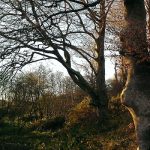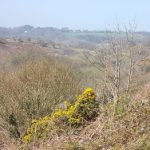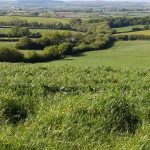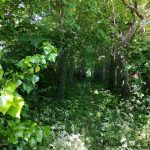The percentage of woodland in the parish today is low, even for Pembrokeshire. However the effect of trees in the landscape is greater than might be expected because of the impact of hedgerow trees. This was probably the case in the past as well. In the nineteenth century some houses had plantings shown on the OS map, which suggest more formalised gardens. These included East Hook and Sutton Lodge.
Hedgerow Trees
The 1887 survey was unusual in that the O.S. attempted to depict actual individual hedgerow and roadside trees. For example, in 1887 the field boundaries around Lambston Hall and Sutton Lodge had many more trees than today. The same was true of the road between Sutton and Lambston.
The change can be illustrated by laying a modern aerial photograph over the old 6 inch OS map (Below). If you do this in a place where there are lots of old trees today. Like the Picton Estate, you can see that the old trees were mapped accurately in 1887. Doing the same exercise around Lambston shows a marked reduction in hedgerows and hedgerow trees.
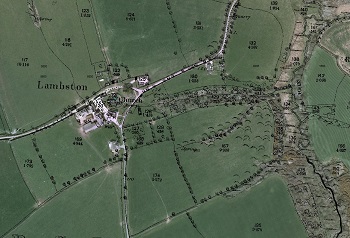
Again around Sutton Lodge many of the shelter belts planted in the nineteenth century have become stag-headed or have died.
Finally the 1887 O.S. map shows the double line of beeches leading to the Quaker Burial Ground, as a mixed plantation of conifers and deciduous trees. This a distinctive landscape feature even today. The age of the trees in the avenue suggests that this was a nineteenth planting. A description of the avenue in 1910 suggests that it was well established by then.
Use of the timber
The 25 inch map of 1887 shows a saw pit at Lambston Hall. This suggests that locally-felled timber was being sawn up for planks on site. In 1841 there was a carpenter called Thomas Roberts living at Lambston Glebe, perhaps he used the products from the saw pit.
A newspaper advertisement from 1853 suggests that the timber from the area was also sold more widely. Walesland was owned at this time by the Camrose estate so it may be that the timber came from a wider area including parts of Camrose.

Tree Species
Tree species in the parish are mixed. Ash and Sycamore probably being the most common. Before the Dutch Elm disease of the 1970s there would have been many more Elm. From these is some surviving elm regrowth from suckers, mainly in hedges. Oak is surprisingly uncommon, especially in the west of the parish, I am not sure why.
Beech has been planted on the avenue at the Quaker Burial Ground. It also forms some of the shelter belts and has been planted in the valley between Lambston Hall and Walesland. The last of these is associated with ponds made in the 1950s for shooting. Blackthorn and Hawthorn are common especially in hedges.
Several woods have the odd scots pine which seems to be a characteristic of this part of Pembrokeshire. In the valley bottom, scrub woodland is increasing. For example along the Pelcomb Brook and on the common. Here the woodland is dominated by willow with some alder.
Looking ahead
Despite attempts from the Welsh Government to increase the rate of woodland planting, there seems to be little inclination to convert farmland to woodland.
The Ash dieback disease (Chalara) has already taken hold in Pembrokeshire. This means that we might expect that perhaps 80% of the ash will die in the next ten years. This is probably to most common tree in the parish so the loss to the landscape and to biodiversity will be considerable. Ash also comprises a high proportion of hedge plants in some areas. I would expect sycamore to take over the place left when the ash has gone and with its much denser shade. from this we might expect a much less varied understory and ground flora, reducing bird and plant life, which has already seen a very significant decline in the last fifty years.
Where ashes die in hedge-banks, flailing may well prevent any replacement trees developing. Where ash makes up a high percentage of the hedge, as on parts of the Haven Road and Lambston Hill we may well lose the hedge altogether without new planting.
What can we do to help the landscape where we live?
- If you have land – why not let some hedgerow trees grow up? They provide shelter from wind and sun for stock and a supply of easily coppiced firewood or wood-chip for heating in the future. I would be happy to help you mark suitable trees to grow on and then you or your contractor just have to lift the flail from time to time.
- As a community we could try and influence the way the common is managed. We would need to work with the community council (who have a guardianship role) and the graziers (who have established rights over the land). Let me know if you think this could be of interest.
- Landowners have the real key here, conservation agencies have little impact in ‘average’ countryside like this. Most of us value woodland and trees in the landscape but an interested and enthusiastic landowner who sees this as a priority could make a contribution the landscape. A group of interested landowners could make a real long-term benefit for wildlife. Grants are available for planting, fencing and management and if interested landowners worked with community groups, other funding could be realised..

